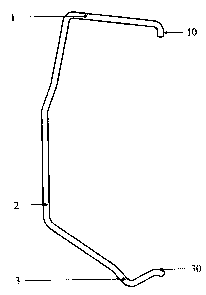Some of the information on this Web page has been provided by external sources. The Government of Canada is not responsible for the accuracy, reliability or currency of the information supplied by external sources. Users wishing to rely upon this information should consult directly with the source of the information. Content provided by external sources is not subject to official languages, privacy and accessibility requirements.
Any discrepancies in the text and image of the Claims and Abstract are due to differing posting times. Text of the Claims and Abstract are posted:
| (12) Patent Application: | (11) CA 2636090 |
|---|---|
| (54) English Title: | HANDLE FOR BEVERAGE CAN |
| (54) French Title: | POIGNEE POUR CANETTE |
| Status: | Deemed Abandoned and Beyond the Period of Reinstatement - Pending Response to Notice of Disregarded Communication |
| (51) International Patent Classification (IPC): |
|
|---|---|
| (72) Inventors : |
|
| (73) Owners : |
|
| (71) Applicants : |
|
| (74) Agent: | GOWLING WLG (CANADA) LLP |
| (74) Associate agent: | |
| (45) Issued: | |
| (22) Filed Date: | 2008-06-25 |
| (41) Open to Public Inspection: | 2009-01-02 |
| Examination requested: | 2012-05-23 |
| Availability of licence: | N/A |
| Dedicated to the Public: | N/A |
| (25) Language of filing: | English |
| Patent Cooperation Treaty (PCT): | No |
|---|
| (30) Application Priority Data: | ||||||
|---|---|---|---|---|---|---|
|
Handle for beverage can comprises an upper portion, a middle portion and a
lower portion, where the shape of said upper portion and lower portion is
matched to
that of the top and bottom edge of said beverage can, as to the upper portion
and
lower portion could grip the beverage can. And said middle portion connects
said
upper portion and lower portion. Drinker could attach the middle portion to
his belt
and let the upper and lower portion grip to the edge of the beverage can. It
is
convenient for user to attach and detach the can handle from the beverage can.
While using the handle clipped to the beverage the user's hand is not in
contact with
the can directly. The means also avoid the direct contact between hand and
cool
drink.
Note: Claims are shown in the official language in which they were submitted.
Note: Descriptions are shown in the official language in which they were submitted.

2024-08-01:As part of the Next Generation Patents (NGP) transition, the Canadian Patents Database (CPD) now contains a more detailed Event History, which replicates the Event Log of our new back-office solution.
Please note that "Inactive:" events refers to events no longer in use in our new back-office solution.
For a clearer understanding of the status of the application/patent presented on this page, the site Disclaimer , as well as the definitions for Patent , Event History , Maintenance Fee and Payment History should be consulted.
| Description | Date |
|---|---|
| Application Not Reinstated by Deadline | 2015-03-05 |
| Inactive: Dead - No reply to s.30(2) Rules requisition | 2015-03-05 |
| Deemed Abandoned - Failure to Respond to Maintenance Fee Notice | 2014-06-25 |
| Inactive: Abandoned - No reply to s.30(2) Rules requisition | 2014-03-05 |
| Inactive: S.30(2) Rules - Examiner requisition | 2013-09-05 |
| Letter Sent | 2012-05-30 |
| All Requirements for Examination Determined Compliant | 2012-05-23 |
| Request for Examination Requirements Determined Compliant | 2012-05-23 |
| Request for Examination Received | 2012-05-23 |
| Appointment of Agent Requirements Determined Compliant | 2010-07-06 |
| Revocation of Agent Requirements Determined Compliant | 2010-07-06 |
| Inactive: Office letter | 2010-07-06 |
| Revocation of Agent Request | 2010-06-10 |
| Appointment of Agent Request | 2010-06-10 |
| Application Published (Open to Public Inspection) | 2009-01-02 |
| Inactive: Cover page published | 2009-01-01 |
| Inactive: IPC assigned | 2008-12-22 |
| Inactive: First IPC assigned | 2008-11-04 |
| Inactive: IPC assigned | 2008-11-04 |
| Inactive: IPC assigned | 2008-11-04 |
| Filing Requirements Determined Compliant | 2008-08-22 |
| Inactive: Filing certificate - No RFE (English) | 2008-08-22 |
| Application Received - Regular National | 2008-08-20 |
| Abandonment Date | Reason | Reinstatement Date |
|---|---|---|
| 2014-06-25 |
The last payment was received on 2013-06-25
Note : If the full payment has not been received on or before the date indicated, a further fee may be required which may be one of the following
Please refer to the CIPO Patent Fees web page to see all current fee amounts.
| Fee Type | Anniversary Year | Due Date | Paid Date |
|---|---|---|---|
| MF (application, 2nd anniv.) - standard | 02 | 2010-06-25 | 2008-06-28 |
| Application fee - standard | 2008-06-28 | ||
| MF (application, 3rd anniv.) - standard | 03 | 2011-06-27 | 2011-06-07 |
| Request for examination - standard | 2012-05-23 | ||
| MF (application, 4th anniv.) - standard | 04 | 2012-06-26 | 2012-05-31 |
| MF (application, 5th anniv.) - standard | 05 | 2013-06-25 | 2013-06-25 |
Note: Records showing the ownership history in alphabetical order.
| Current Owners on Record |
|---|
| EDWARD C. MAYLED |
| ANTONY MAYLED |
| Past Owners on Record |
|---|
| None |